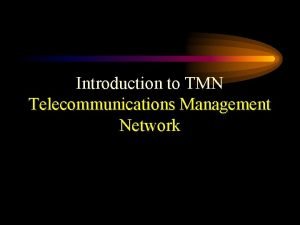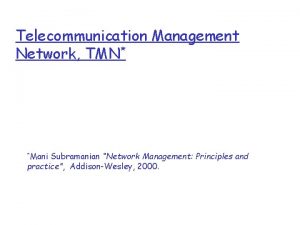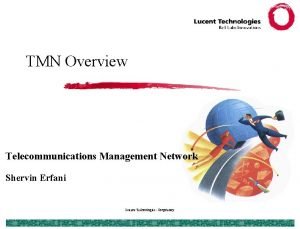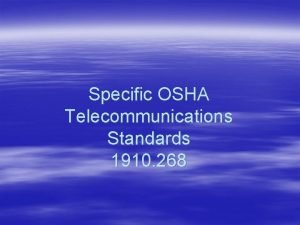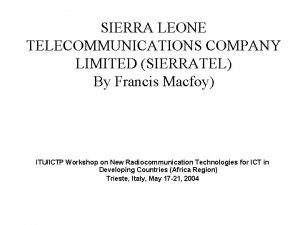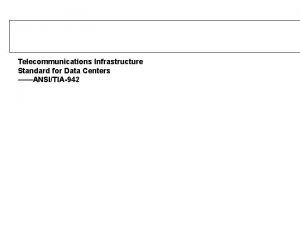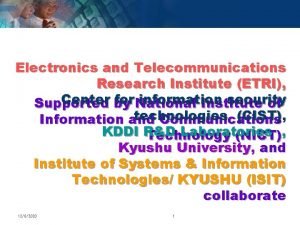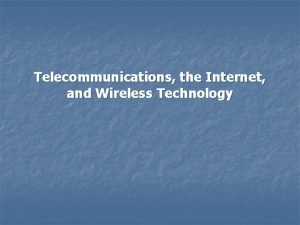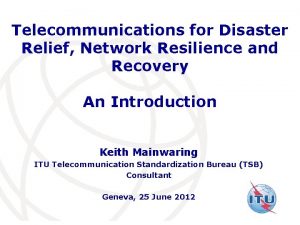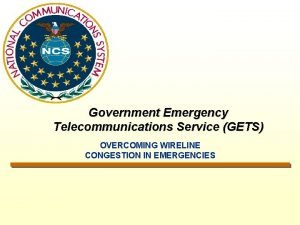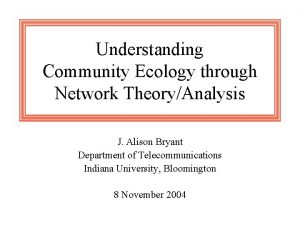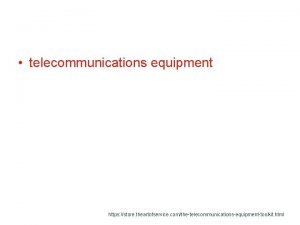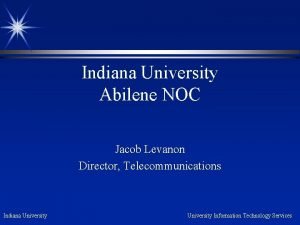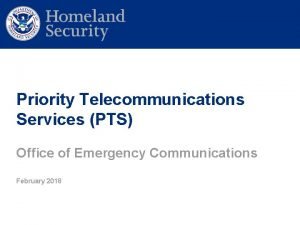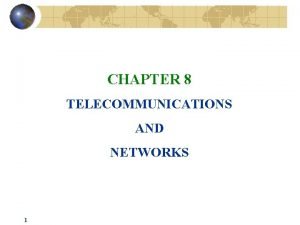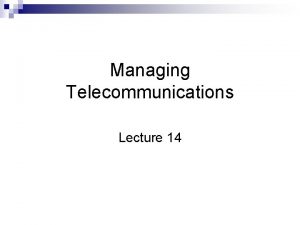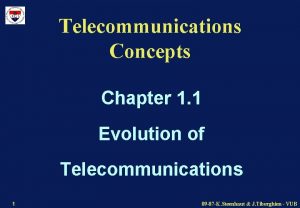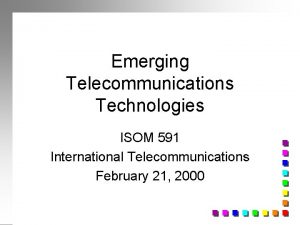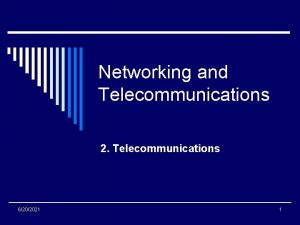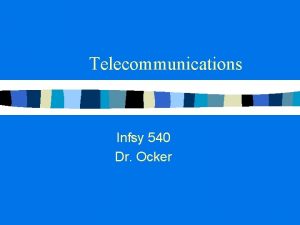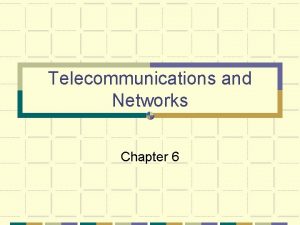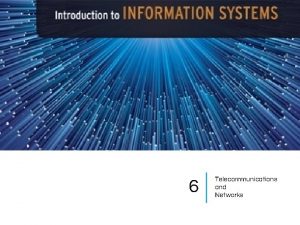Introduction to Telecommunications Telecommunication Network Telecommunication is the































- Slides: 31

Introduction to Telecommunications


Telecommunication Network § § Telecommunication is the mean of transmission of information over distances The information may be in the form of voice telephone calls, data, text, images, or video 3

Why Networking ? § Resource sharing ð Sharing hardware (printers, processors, etc. ) ð Sharing software (programs, data files) § High reliability ð Could set automatic backup of programs and data at different locations ð Fault tolerance (if one server is down, another provides service. If a disk fails, a mirror disk may be available) § Cost saving § Communication tool ð Internal email service ð Remote Access service 4

Applications of Telecommunications Business Telecommunications Architectures Electronic communications system • • • Electronic mail Voice mail Bulletin Board systems Videotex Fascimile Public Information Service Electronic meeting systems • Desktop Video conferencing • Decision room conferencing • Computer conferencing • Teleconferencing • • • Centralized Distributed Client/server Interorganizational Global Business process systems • Online transaction processing • Inquiry/Response • EDI / XML • Electronic Funds Transfer • Activity monitoring • Process control • Telecommuting

Trends Industry Trends Towards a greater number of competitive vendors, carriers, alliances and telecommunications network services. Technology Trends Towards open and interconnected local and global digital networks for voice, data and video, using high-speed fiber-optics and satellites. Application Trends Towards a pervasive use of the internet and enterprise and interorganizational intranets, to support collaborative computing, online business operations and strategic advantage in local and global markets.

Technological Developments General trend: Connect everybody to everybody else. § Internet-network technologies ð thousands new hardware- and software products ð web-browsers, HTML- editors, firewalls § Open systems: based on standards ð connectivity of systems: middleware ð OSI, TCP/IP § Digital technologies ð higher transmission speed ð larger information streams ð more efficient transmission method ð less errors

Internet Revolution § § Explosive growth Terminology ð WWW: ð ð ð E-mail: Usenet: IRC: FTP: Telnet: Other: inquiry sources of information via graphical browser software electronic mail place messages on bulletin board real time dialogs file transfer login on other systems telephone, video conferencing, . . .

Telecommunication model § Terminals ð terminal, office equipment , telephones , . . . § Telecommunications processors ð modems, multiplexers, front-end processors, . . . § Telecommunications channels and media ð copper wires, coaxial cables, fiber optic cables, satellites, . . . § Computers ð host computers, front-end computers, network servers, . . . § Telecommunications control software ð telecommunication monitors, network operating systems, . . .

Telecommunication Components Telecom Channels and Media Telecom processors End-user workstation Telecom processors Telecommunications software Computers

Components of Telecommunications Network 1. Terminals for accessing the network. 2. Computers that process information and are interconnected by the network. 3. Links that form a channel through which information is transmitted from a sending device to a receiving device. 4. Equipment that facilitates the transmission of information. 5. Software that controls message transmission over the network. 11

Elements of Communication Network

Network Services Network services are classified into two distinct categories, namely connection-oriented service and connectionless service. § Type of network service significantly effects - The bandwidth provided to users, - The range of applications supported, - The extent of resource utilization §

Network topology § § Defines the physical interconnection of its constituent elements. Interconnection are real or logical. Real interconnection refers to the way the elements are physically connected. Logical interconnection refers to the way data is exchanged between the constituent elements.

Network Classification

Classification of telecommunication networks § § § Spatial distance (coverage area) (LAN, MAN, WAN) Network Ownership (Public, Private, VPN) Type of information it carries (voice, data, video) Topology (configurations of networks) (Star, Bus, Tree, Mesh, hybrid, …. ) Type of switching technology (such as circuit, message, and packet switching) Communication model between nodes

Geographical extension § § § Geographical extent influences various aspects of a network like maximum bandwidth, error rates, and ease of management are related to geographical extent.

Geographical extension Three principal types of telecommunications networks can be distinguished from the point of view of their geographical scope. They are: 1. Local area networks 2. Wide area networks 3. Metropolitan area networks 18

LAN PC-workstation Databases and Software packages Shared hard disk Network Server Shared printer PC-workstation Port to other networks

Local Area Network (LAN) - Small geographic area (e. g. room, office) • contrast to wide-area networks (WANs) - Controlled by one administrative authority - Usually high speed •

LANs are shared communication systems to which various nodes are attached. § General Characteristics of LANs: − Have a diameter in the order of few kilometers. − Are privately owned by an organization. − Low error rates − High bandwidth (4 -16 to 100 -1000 Mbps) For e. g. , Ethernet, Token Ring, FDDI and ATM §

WAN - Internetwork LAN’s Mainframe, hosts network in US network in Europe LAN’s Tymnet Internet network in Australia Cisco corporation network

Wide Area Network (WAN) - Computer network that covers a broad area • crosses metropolitan, regional, or national boundaries - Uses routers and public communications links

Wide Area Network (WAN) - used to connect LANs and other types of networks together - Option for WAN connectivity: 1 - Leased Line 2 - Circuit switching 3 - Packet switching 4 - Cell relay • Speed from 1200 bits/s to 6 Mbit/s

WANs cover large geographical distances spanning multiple states/countries and are used primarily to connect dispersed sites. § General Characteristics of WANs: − Have a diameter in the order of few 1000 Km − Are seldom owned by one organization. − Bandwidth is very costly. − Bandwidth is in the order of 1 -45 Mbps. − Error-rates are high For e. g. , X. 25, Frame Relay and ATM §

Differences between LAN, WAN, & MAN LAN 1. 2. MAN Cover a larger geographic 1. Cover a largest distance. physical area than LAN. 2. Best WAN types used with Best LAN types used with 2. Used with in internet & Ethernet. 3. Less speed than LAN. Connection in small and 1. WAN Internet. 3. Faster than WAN. 3. Higher speed. 4. More expensive. 4. Cheaper. 4. Competitive price 5. Less likely need password 5. More likely need 5. Need password validation as it will have specific user rights. will have specific user rights. 6. Less private. 7. Hardware focus on rights. 6. High security. 6. More private. 7. Hardware focus on data 7. Hardware focus on sharing resources. transmission. 8. Operated by organizations communication. 8. Operate on client to server.

Network Topology § Star ðall communications go via the central system § Bus ðcan easily be extended at the ends § Ring ðmore secure

Star network With direct connections Point-to-point lines - Efficient , also for high speeds - With a large number of workstations cabling might be a problem

Star network (multiplexed) Access via multiplexed lines eventually rented - local speed up to 2000 char/sec , 1 M char/sec very expensive - internationally 1000 char/sec commonly available

Bus network Shared usage of a broadband network Multidrop lines - more complex hardware - simpler cabling system

Ring Networks Ring Network - more equal basis
 Telecommunications network architecture
Telecommunications network architecture Tmn network management
Tmn network management Kyushu telecommunication network co.,inc.
Kyushu telecommunication network co.,inc. Telecommunication management network
Telecommunication management network Telecommunication processors
Telecommunication processors Telecommunication management network
Telecommunication management network Network management principles and practice
Network management principles and practice A pioneer in the field of telecommunications
A pioneer in the field of telecommunications Telecom risk management
Telecom risk management It means communication at a distance
It means communication at a distance Osha telecommunications standards
Osha telecommunications standards Sierra leone telecommunications company
Sierra leone telecommunications company Telecommunications act of 1996
Telecommunications act of 1996 Venture capital telecommunications
Venture capital telecommunications Unstructured cabling
Unstructured cabling Electronics and telecommunications research institute
Electronics and telecommunications research institute Telecommunications, the internet, and wireless technology
Telecommunications, the internet, and wireless technology Telecommunication for dummies
Telecommunication for dummies Telecommunications the internet and wireless technology
Telecommunications the internet and wireless technology Disaster recovery telecommunications
Disaster recovery telecommunications Rfp for telecommunications services
Rfp for telecommunications services Government emergency telecommunications service
Government emergency telecommunications service Telecommunications engineering
Telecommunications engineering Telecommunications for dummies
Telecommunications for dummies Department of telecommunications
Department of telecommunications Department of telecommunications
Department of telecommunications French telecommunications equipment company
French telecommunications equipment company Digital telecommunications
Digital telecommunications Iu telecommunications
Iu telecommunications European telecommunications standards institute
European telecommunications standards institute Ee3801
Ee3801 Government emergency telecommunications service
Government emergency telecommunications service

